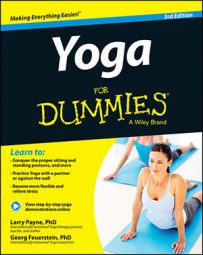Okay, you’ve decided to try Yoga. What’s the next step? Safest is to set your sights on a suitable Yoga class or teacher instead of plowing forward as a strict do-it-yourselfer. Although you can explore some basic practices by reading about them, a full-fledged, safe Yoga routine really requires proper instruction from a qualified teacher.
Checking out classes and teachers
These days, it seems you can find a Yoga class on every corner in large cities, so urbanites have lots of choices. But even country folk should be able to find an option that works. Here are some suggestions for finding the Yoga class that’s right for you, wherever you live:
Put out the word that you’re looking. You may get lots of referrals and suggestions.
Search online for studios and classes in your area. If you find a site that rates the offerings, check out the comments and see what others say.
Stop in at your local YMCA/YWCA or adult education center to check class offerings.
Look into the possibilities at your local health club. However, before you join a Yoga session there, make sure the teacher is really qualified. How much training has he had? Has she been certified by a recognized or registered Yoga teacher training school or instructor?
Explore online Yoga sites that offer taped or streamed Yoga classes. Many sites offer classes in a range of styles for a variety of abilities and preferences.
Visiting a few places and teachers is important before you commit to a course or a series of classes.
Bring a written checklist to your class visit. If you don’t want to be so obvious, memorize the points you want to check out. Here are some ideas for your list:
How do I feel about the building or classroom atmosphere?
What’s my gut response to the teacher? Does he create a safe environment that inspires trust?
Do I prefer a male or female teacher?
Does the teacher or school have a good reputation?
How large are the classes? Will I be able to receive individual attention from the teacher as I practice in the class?
When checking out a Yoga center, don’t hesitate to ask questions of the instructor or other staff members about any concerns you have. In particular, find out what style of Hatha Yoga the center offers. Some styles — notably Ashtanga, or Power Yoga — demand athletic fitness. Others embody a more relaxed and adaptable approach. Choose what is right for you.
If you’re not familiar with the style of a particular school, don’t hesitate to ask for an explanation.
Making sure the course fits your experience level
Many Yoga studios and community centers that teach Yoga offer introductory courses (4 to 6 weeks), so you don’t have to jump into the deep end. If you’re a beginner, look for a beginner’s course. You’re likely to feel more comfortable in a group that’s starting at the same skill level instead of being surrounded by advanced practitioners who can perform difficult postures easily and elegantly.
Whatever the skill level of a class, don’t feel self-conscious. None of the advanced students will stare at you to see whether the new kid in class is any good. You may get a few encouraging smiles, though.
Beginner’s classes are sometimes advertised as Easy Does It Yoga or Gentle Yoga.
As a beginner, stay away from overly large classes or mixed-level classes that lump together Yoga freshmen with postgraduates. While some highly skilled and experienced teachers can manage such classes well, chances are, the teacher can’t give you the attention you need to ensure your safety.
The dilemma is that many of the more experienced teachers are quite popular, and their classes tend to be large. If you find yourself as a newbie in a large class, let the teacher know you’re a beginner, and bring up any physical limitations you may have. Then stake out a spot where the instructor can observe you throughout the class, or at least from time to time.
After a few classes and with the benefit of an instructor’s step-by-step guidance, you can certainly continue practicing and exploring Yoga on your own.
Taking other important considerations into account
Just as not all Yoga classes and Yoga teachers are alike, the length of the class and the cost per class both vary, depending on the mode of instruction you choose. Your level of commitment plays a role in how much your individual sessions cost.
Time commitment: The length of a group Yoga class varies from 50 to 90 minutes. Health clubs, fitness spas, and corporate classes are normally 50 to 60 minutes long, but beginning classes at Yoga centers usually last for 75 to 90 minutes. A private Yoga lesson customarily lasts 1 hour.
Cost: In general, group Yoga classes are pretty affordable. The cheapest classes are usually available at adult education centers and at community and senior centers. YWCA classes also tend to be reasonably priced. If you have a health club membership, check to see if your gym includes free Yoga classes as part of the package.
Most regular Yoga centers in metropolitan areas charge an average of $15 to $20 per class. A one-time drop-in fee (for anyone who hasn’t committed to taking more than one class) is usually a few dollars higher. Some schools offer the first class free, and others may charge as much as $25. On the other end, many Yoga studios now offer community classes at a reduced fee or donation basis.
When you’re considering a commitment to a Yoga center, check into the larger packages — they’re often a good investment. Obviously, private lessons are quite a bit more expensive than group classes and range from $50 to $250. If you’re uncomfortable with the price you’re quoted for Yoga classes, continue to seek out a more reasonable offer.

